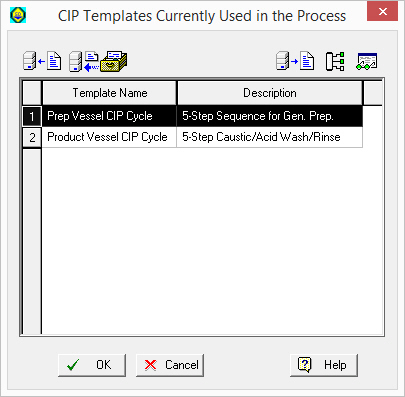

This dialog appears when you select Tasks } Other Resources } CIP Templates... from the main menu of the application or Resources } CIP Templates... from the flowsheet’s command menu.
This list presents all CIP templates that are currently in use by CIP operations in the process. Select a CIP template (will show as a highlighted row) and then click the View/Edit Properties button ( ) at the top-right of the table or double click on the row. You will be presented with a dialog that allows you to edit the properties of the selected CIP template as is now in the current process file. Clicking on the View Locations Used button (
) at the top-right of the table or double click on the row. You will be presented with a dialog that allows you to edit the properties of the selected CIP template as is now in the current process file. Clicking on the View Locations Used button ( ) will present you with a dialog which shows where exactly which CIP operations are linked to this CIP template in the process. For more details, see CIP Template Definition Dialog and Locations where a CIP Template Is Used Dialog.
) will present you with a dialog which shows where exactly which CIP operations are linked to this CIP template in the process. For more details, see CIP Template Definition Dialog and Locations where a CIP Template Is Used Dialog.
|
|
A (named) CIP template in a process may or may NOT exist in your ‘SuperPro (User)’ database. If the CIP template was originally introduced in your ‘User’ database, it will be there. However, if you are viewing a process model created by another user, he/she may have the original definition of the CIP template in their ‘SuperPro (User)’ database. Your process file of course, contains a local copy of that definition so that it is able to function without access to the original CIP template. You can edit the template’s properties and even export the template in your ‘SuperPro (User)’ database (see Notes below). |
NOTES:
b) Note that any changes will only affect the current copy of the CIP template (as used in this model) and they will not be reflected in the values stored in the CIP template databank or in any other process files that utilize the same CIP template.
d) You cannot explicitly add or delete CIP templates to this list. The list is automatically updated by the application as you engage the services of a CIP template from the databank (i.e., link a CIP operation to a CIP template in your ‘User’ database).
If you have modified the properties of a CIP template as utilized in this process model, and you wish to update its database record based on its current values, then click on the Update Record in DB button ( ). This will make the record kept in the database identical to the object as it now exists in your process file. If a CIP template with the same name does NOT exist in your databank, then this button is disabled. To create a new record in the databank see (e) below.
). This will make the record kept in the database identical to the object as it now exists in your process file. If a CIP template with the same name does NOT exist in your databank, then this button is disabled. To create a new record in the databank see (e) below.
If you have modified the properties of a CIP template and you wish to reset its values to how they exist in the database, then click on the Update Properties from DB Record button ( ). This will refresh the values of the object in the process file to match the values of the CIP template as they exist in the database. If a CIP template with the same name does NOT exist in your databank, then this button is disabled.
). This will refresh the values of the object in the process file to match the values of the CIP template as they exist in the database. If a CIP template with the same name does NOT exist in your databank, then this button is disabled.
If a selected CIP template does NOT exist in your databank (either it used to exist and later deleted, or it was never defined there as the process model was created by someone else), you can export and keep a definition of this CIP template in your databank by clicking on the Export to DB button ( ). Please note that this button will be active, even if a CIP template with that name already exists in your databank. In that case, you will get a chance to introduce a new record in the databank for this template, but under a different name. This option is useful if you have modified the properties of the template as they existed in the databank, and you wish to keep the modified version of the template as well as the original.
). Please note that this button will be active, even if a CIP template with that name already exists in your databank. In that case, you will get a chance to introduce a new record in the databank for this template, but under a different name. This option is useful if you have modified the properties of the template as they existed in the databank, and you wish to keep the modified version of the template as well as the original.